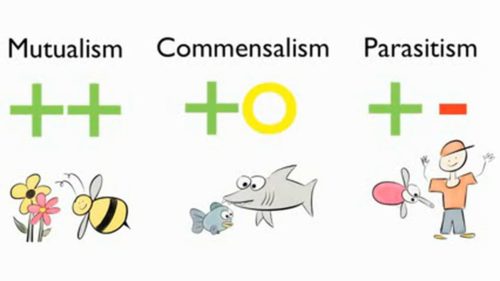Explain How Mutualism Is Different Than Commensalism
5 rows Main Difference. Parasitism is a type of interaction between two organisms where one species is benefitted while the other is harmed partially or completely.
Difference Between Mutualism And Commensalism Definition Features Examples
Though it is an interspecific interaction cooperation term is used to explain their mutually beneficial interaction between the individuals of the same species which often includes social interactions.
. Commensalism and Parasitism both benefit one organism but parasitism hurts the other organism and commensalism does not. Mutualism is when both species benefit in the relationship. In Commensalism two different species interact with out other and the commensal alone gets benefits without harming the host.
When only one partner or organism gets benefits without any effect on the other is commensalism. Commensalism is when one organism benefits while the host is left unharmed- but also doesnt really get anything in return unlike mutualism. Mutualism is different than Commensalism because Mutualism helps both organisms and commensalism only help one while the other is not harmed.
When both the partners or organisms get benefits from one another by living together is known mutualism. Mutualism represents a symbiotic relationship where both species involved benefit from the relationship. This type of case is typical among species that present biological characteristics compatible with each other being able to provide positive feedback that is to give mutual benefit.
For example lichens represent an intimate mutualistic relationship between a fungus and photosynthesizing algae. 5 How is mutualism different from commensalism. Mutualism Parasitism and Commensalism.
2 How is parasitism different from commensalism quizlet. 4 What do parasitism mutualism and commensalism have in common How are they different quizlet. Commensalism is a relationship between two organisms where one organism benefits but the other is unaffected.
The main difference between the mutualism and commensalism is that. However they are the similar as it is a. The term commensalism comes from the Latin cum mess which translates as.
Unlike commensalism in which only one species involved benefits in the case of mutualism it is both species that benefit from their interaction. The main difference lies in whether one or both of the organisms benefits from the relationship. Then explain how each organism is affected by the relationship Columns 2.
Mutualism is where both organisms benefit commensalism is where one benefits but the other organism isnt harmed and lastly parasitism is where one organism benefits and the other is harmed. Mutualism is where all species benefits commensalism is where one species benefits more than the other and parasitism is where one species benefits more while the other gets affected. Mycorrhizae is the relationship between fungi and roots of higher plants.
Learn about the different types of symbiotic relationships. There are a total of three types of biotic symbioses. Mutualism represents a symbiotic relationship where both species involved benefit from the relationship.
Parasitism is when an organism lives as a parasite on another parasite. Understand how different species can exist in symbiotic relationships. Commensalism is when one organism benefits whereas the other one is not harmed.
Like a shark and remoras those fish with suction-cup heads hitchhike. Therefore the major difference between mutualism and commensalism is that both organisms benefit in mutualism while only one organism benefits in commensalism but the other one is not affected. Mutualism is the interaction where both the organisms are benefited.
It is the interaction between two or more entities wherein both the entities can benefit from the interaction. Commensalism and parasitism are two symbiotic relationships seen between organisms. Commensalism is known as a specific type of interspecific biological interaction that is of interaction between individuals of different species characterized by the benefit of only one of those involved without the other party receiving any type of damage or harm.
The various species found within a single ecosystem can relate to each other in a variety of ways. The relationship of mutualism is obligatory commensalism is obligatory while that of parasitism is either obligatory or facultative. In Mutualism two different species interact and take mutual benefits for a long or short period of time.
1 Explain How Parasitism Differs From Commensalism. 3 What is the key difference between mutualism and parasitism. So to review mutualism is where both organisms benefit commensalism is where one benefits and the other is unaffected and parasitism is.
Commensalism and mutualism both describe a symbiotic relationship between two organisms. 6 What is the difference between. Sharks arent hurt but the remoras get free transportation and access to food scraps.
Mutualism is the interaction between two or more organisms where both organisms can benefit from the interaction. The terms mutualism commensalism parasitism and symbiosis all refer. An example of mutualism is.
On the other hand commensalism represents a symbiotic relationship where only one organism benefits while the. When one partner or organism gets benefits while the other is harmed is known as parasitism. Mutualism parasitism commensalism and.
Fungi help the plant in the absorption of essential nutrients from the soil. Mutualism is further subdivided into two categories that define how dependent the organisms are on each other for survival.
Relationships The Bay The Ecology Of The Chesapeake Bay

5 Difference Between Mutualism Commensalism And Parasitism With Table Core Differences

21 Explain The Difference Between Commensalism And Mutualism Types Of Class12 Bio Past Year Paper Youtube

0 Response to "Explain How Mutualism Is Different Than Commensalism"
Post a Comment